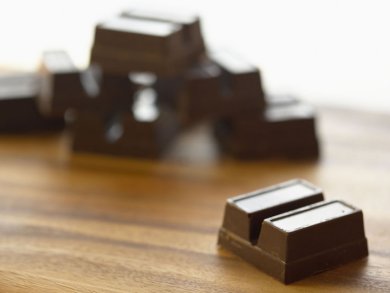Traditional chocolate uses only fermented, roasted cocoa beans, which provide cocoa mass and fat. The rest of the cocoa fruit, including the pulp, outer shell, and inner shell (endocarp), is rarely used, often being burned.
Kim Mishra and colleagues, ETH Zurich, Switzerland, have developed a chocolate that uses solely cocoa pod components in the chocolate and includes cocoa, pulp, and endocarp. The sweet pulp allows for a reduction in added sugar, and the new chocolate contains more healthy fibers. The team extracted, dried, and milled the fibrous endocarp into a powder. They harvested the cocoa bean pulp and pressed it for its juice. The cocoa pulp juice concentrate and the endocarp powder were mixed and heated to a gel that is added to cocoa mass from cocoa beans.
The team systematically tested the consistency of different compositions, while trained taste testers evaluated sweetness and flavor. They discovered that adding up to 20 % gel achieves the right balance of sweetness and consistency. The natural sweetness of cocoa pulp equates to about 5-10 % added sugar, reducing the refined sugar content by nearly half compared to typical dark chocolate. The ETH has patented the recipe.
The new cocoa fruit chocolate contains only 23 g of saturated fats, compared to about 33 g in regular dark chocolate. Higher intake of saturated fats is linked to increased cardiovascular disease risk. This chocolate also has more fiber than average dark chocolate, helping regulate digestion and stabilize blood sugar levels.
Additionally, this new recipe could diversify income for small farmers. Besides selling cocoa beans, they could sell the pulp juice and endocarp, generating three revenue streams. Enhancing the value of the cocoa fruit also promotes sustainability.
It will take time before cocoa fruit chocolate hits the market. The supply chain needs to be established, starting with cocoa farmers who need drying facilities for pulp juice and endocarp. Once enough powder is produced, chocolate manufacturers can scale up production and marketing.
- Valorization of cocoa pod side streams improves nutritional and sustainability aspects of chocolate,
Kim Mishra, Ashley Green, Johannes Burkard, Irina Gubler, Roberta Borradori, Lucas Kohler, Johannes Meuli, Ursina Krähenmann, Jotam Bergfreund, Armin Siegrist, Maria Schnyder, Alexander Mathys, Peter Fischer, Erich J. Windhab,
Nature Food 2024.
https://doi.org/10.1038/s43016-024-00967-2
Also of Interest

Chocolate is a cultural asset of mankind. Klaus Roth proves, once again, only chemistry is able to produce such a celestial pleasure



